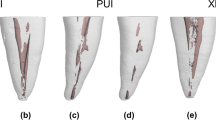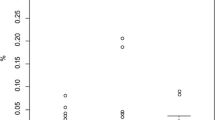Abstract
The aim of this study was to compare different obturation techniques in severely curved canals in terms of the percentage of gutta-percha filled area and voids. The obturation times and the incidence of extrusion of filling material were also compared. Curved root canals (curvature, 25–35°) of 48 extracted human teeth were enlarged with Mtwo rotary NiTi instruments and obturated as follows: Group A: 0.04/35 matched-single-cone; Group B: cold lateral compaction with 0.04/35 gutta-percha master cone; Group C: warm vertical compaction; Group D: lateral compaction with standardized gutta-percha master cone. In all groups AHPlus was used as sealer. The teeth were sectioned horizontally at 2, 3, 4, 6 and 8 mm from the apex. The total area of each canal segment was measured and the areas of gutta-percha, sealer and voids were converted to percentages of the total area. Data were subjected to the Kruskal–Wallis and post hoc Dunn test. Obturation times were compared using ANOVA and post hoc Student–Newman–Keuls test. The matched-single-cone obturation (group A) was significantly the fastest method while warm vertical compaction (group C) required significantly more time than all other techniques (p < 0.05). No significant differences were obtained between the groups in terms of percentage of voids at any level (p > 0.05). At all levels, groups B, C, and D produced significantly higher gutta-percha filled areas (p < 0.05) and lower sealer-filled areas (p < 0.05) than group A. No significant differences were found between groups B, C, and D (p > 0.05) regarding gutta-percha and sealer-filled areas. Within the limitations of the in vitro study, it can be concluded that lateral compaction of greater taper gutta-percha cones is a fast and efficient method for obturation of curved canals.
Similar content being viewed by others
References
Mollander A, Reit C, Dahlén G, Kvist T (1998) Microbiological status of root-filled teeth with apical periodontitis. Int Endod J 31:1–7
Schilder H (1967) Filling root canals in three dimensions. Dent Clin North Am 11:723–744
Jarrett IS, Marx D, Covey D, Karmazin M, Lavin M, Gound T (2004) Percentage of canals filled in apical cross sections—an in vitro study of seven obturated techniques. Int Endod J 37:392–398
Gilhooly RM, Hayes SJ, Bryant ST, Dummer PM (2000) Comparison of cold lateral condensation and a warm multiphase GP technique for obturating curved root canals. Int Endod J 33:415–420
Gulabivala K, Holt R, Long B (1998) An in vitro comparison of thermoplasticised gutta-percha obturation techniques with cold lateral condensation. Endod Dent Traumatol 14:262–269
McMurtrey LG, Krell KV, Wilcox LR (1992) A comparison between Thermafil and lateral condensation in highly curved canals. J Endod 18:68–71
De-Deus G, Reis C, Beznos D, Gruetzmacher de Abranches AM, Coutinho-Filho T, Pactornik S (2008) Limited ability of three commonly used thermoplasticized gutta-percha techniques in filling oval-shaped canals. J Endod 34:1401–1405
Brayton SM, Davis SR, Goldmann M (1973) Gutta-percha root canal fillings: an in vitro analysis—part 1. Oral Surg Oral Med Oral Pathol Oral Radiol Endod 35:226–231
Wu MK, Özok AR, Wesselink PR (2000) Sealer distribution in root canals obturated by three techniques. Int Endod J 33:340–345
Kontakiotis EG, Wu MK, Wesselink PR (1997) Effect of sealer thickness on long-term sealing: a 2-year follow-up study. Int Endod J 30:307–312
Schäfer E, Zandbiglari T (2003) Solubility of root canal sealers in water and artificial saliva. Int Endod J 36:660–669
Kazemi RB, Safavi KE, Spangberg LSW (1993) Dimensional changes of endodontic sealers. Oral Surg Oral Med Oral Pathol 76:766–771
Keçeci AD, Çelik Ünal G, Şen H (2005) Comparison of cold lateral compaction and continuous wave of obturation techniques following manual or rotary instrumentation. Int Endod J 38:381–388
Gulsahi KG, Cehreli ZC, Onay EO, Tasman-Dagli F, Ungor M (2007) Comparison of the area of resin-based sealer and voids in roots obturated with Resilon and gutta-percha. J Endod 33:1338–1341
Souza EM, Wu MK, van der Sluis LW, Leonardo RT, Bonetti-Filho I, Wesselink PR (2009) Effect of filling technique and root canal area on the percentage of gutta-percha in laterally compacted root fillings. Int Endod J 42:719–726
Ordinola-Zapata R, Bramante CM, de Moraes IG, Bernardineli N, Garcia RB, Gutmann JL (2009) Analysis of the gutta-percha filled area in C-shaped mandibular molars obturated with a modified MicroSeal technique. Int Endod J 42:186–197
De-Deus G, Gurgel-Filho ED, Magalhães KM, Coutinho-Filho T (2006) A laboratory analysis of gutta-percha-filled area obtained using Thermafil, System B and lateral condensation. Int Endod J 39:378–383
James BL, Brown CE, Legan JJ, Moore BK, Vail MM (2007) An in vitro evaluation of the contents of root canals obturated with gutta-percha and AH-26 sealer or Resilon and Epiphany sealer. J Endod 33:1359–1363
Ardila CN, Wu MK, Wesselink PR (2003) Percentage of filled canal area in mandibular molars after conventional root-canal instrumentation and after noninstrumentation technique (NIT). Int Endod J 36:591–598
Wu MK, van der Sluis LWM, Wesselink PR (2002) A preliminary study of the percentage of gutta-percha-filled area in the apical canal filled with vertically compacted warm gutta-percha. Int Endod J 35:527–535
Pagavino G, Giachetti L, Nieri M, Giuliani V, Scaminaci Russo D (2006) The percentage of gutta-percha-filled area in simulated curved canals when filled using Endo Twin, a new heat device source. Int Endod J 39:610–615
Gordon MP, Love RM, Chandler NP (2005) An evaluation of.06 tapered gutta-percha cones for filling of 0.06 taper prepared curved root canals. Int Endod J 38:87–96
Romania C, Beltes P, Boutsioukis C, Dandakis C (2009) Ex-vivo area-metric analysis of root canal obturation using gutta-percha cones of different taper. Int Endod J 42:491–498
Schäfer E, Vlassis M (2004) Comparative investigation of two rotary nickel-titanium instruments: ProTaper versus RaCe. Part 2. Cleaning effectiveness and shaping ability in severely curved root canals of extracted teeth. Int Endod J 37:239–248
van der Borden WG, Wu MK, Wesselink PR (2010) Percentages of gutta-percha-filled canal area observed after increased apical enlargement. J Endod 36:139–142
Wu MK, de Groot SD, van der Sluis LWM, Wesselink PR (2003) The effect of using an inverted master cone in a lateral compaction technique on the density of the gutta-percha fill. Oral Surg Oral Med Oral Pathol Oral Radiol Endod 96:345–350
VanGheluwe J, Wilcox LR (1996) Lateral condensation of small, curved root canals: comparison of two types of accessory cones. J Endod 22:540–542
Schäfer E, Erler M, Dammaschke T (2006) Comparative study on the shaping ability and cleaning efficiency of rotary Mtwo instruments. Part 2. Cleaning effectiveness and shaping ability in severely curved root canals of extracted teeth. Int Endod J 39:203–212
Hembrough MW, Steiman HR, Belanger KK (2002) Lateral condensation in canals prepared with nickel-titanium rotary instruments: an evaluation of the use of three different master cones. J Endod 28:516–519
Conflict of Interest
The authors declare that they have no conflict of interest.
Author information
Authors and Affiliations
Corresponding author
Rights and permissions
About this article
Cite this article
Schäfer, E., Nelius, B. & Bürklein, S. A comparative evaluation of gutta-percha filled areas in curved root canals obturated with different techniques. Clin Oral Invest 16, 225–230 (2012). https://doi.org/10.1007/s00784-011-0509-z
Received:
Accepted:
Published:
Issue Date:
DOI: https://doi.org/10.1007/s00784-011-0509-z




